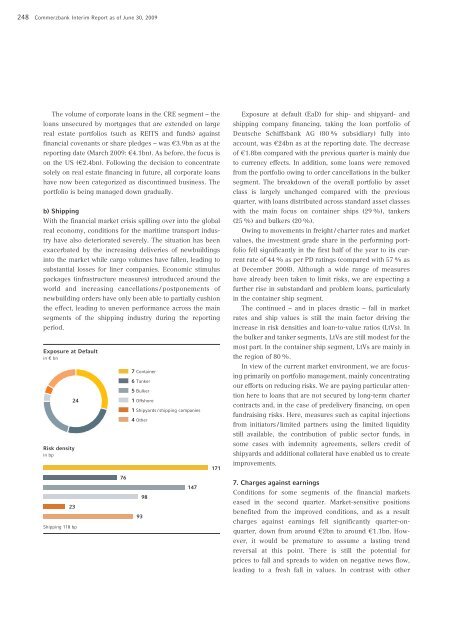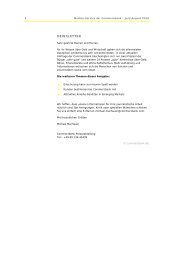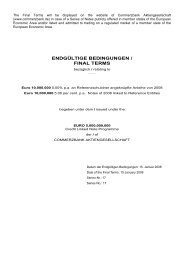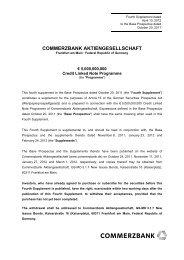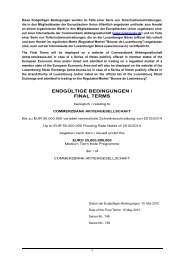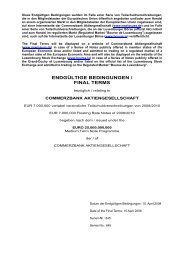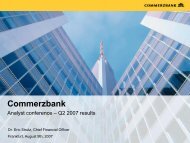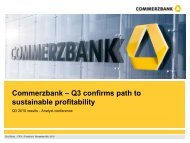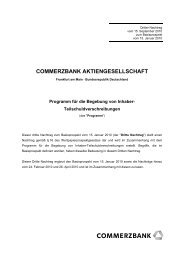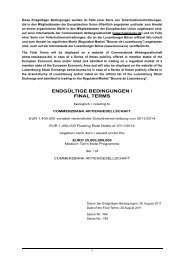COMMERZBANK AKTIENGESELLSCHAFT
COMMERZBANK AKTIENGESELLSCHAFT
COMMERZBANK AKTIENGESELLSCHAFT
Create successful ePaper yourself
Turn your PDF publications into a flip-book with our unique Google optimized e-Paper software.
248 Commerzbank Interim Report as of June 30, 2009<br />
The volume of corporate loans in the CRE segment – the<br />
loans unsecured by mortgages that are extended on large<br />
real estate portfolios (such as REITS and funds) against<br />
financial covenants or share pledges – was €3.9bn as at the<br />
reporting date (March 2009: €4.1bn). As before, the focus is<br />
on the US (€2.4bn). Following the decision to concentrate<br />
solely on real estate financing in future, all corporate loans<br />
have now been categorized as discontinued business. The<br />
portfolio is being managed down gradually.<br />
b) Shipping<br />
With the financial market crisis spilling over into the global<br />
real economy, conditions for the maritime transport industry<br />
have also deteriorated severely. The situation has been<br />
exacerbated by the increasing deliveries of newbuildings<br />
into the market while cargo volumes have fallen, leading to<br />
substantial losses for liner companies. Economic stimulus<br />
packages (infrastructure measures) introduced around the<br />
world and increasing cancellations / postponements of<br />
newbuilding orders have only been able to partially cushion<br />
the effect, leading to uneven performance across the main<br />
segments of the shipping industry during the reporting<br />
period.<br />
Exposure at Default<br />
in € bn<br />
Risk density<br />
in bp<br />
23<br />
24<br />
Shipping 118 bp<br />
76<br />
7 Container<br />
6 Tanker<br />
5 Bulker<br />
1 Offshore<br />
1 Shipyards / shipping companies<br />
4 Other<br />
93<br />
98<br />
147<br />
171<br />
Exposure at default (EaD) for ship- and shipyard- and<br />
shipping company financing, taking the loan portfolio of<br />
Deutsche Schiffsbank AG (80 % subsidiary) fully into<br />
account, was €24bn as at the reporting date. The decrease<br />
of €1.8bn compared with the previous quarter is mainly due<br />
to currency effects. In addition, some loans were removed<br />
from the portfolio owing to order cancellations in the bulker<br />
segment. The breakdown of the overall portfolio by asset<br />
class is largely unchanged compared with the previous<br />
quarter, with loans distributed across standard asset classes<br />
with the main focus on container ships (29 %), tankers<br />
(25 %) and bulkers (20 %).<br />
Owing to movements in freight / charter rates and market<br />
values, the investment grade share in the performing portfolio<br />
fell significantly in the first half of the year to its current<br />
rate of 44 % as per PD ratings (compared with 57 % as<br />
at December 2008). Although a wide range of measures<br />
have already been taken to limit risks, we are expecting a<br />
further rise in substandard and problem loans, particularly<br />
in the container ship segment.<br />
The continued – and in places drastic – fall in market<br />
rates and ship values is still the main factor driving the<br />
increase in risk densities and loan-to-value ratios (LtVs). In<br />
the bulker and tanker segments, LtVs are still modest for the<br />
most part. In the container ship segment, LtVs are mainly in<br />
the region of 80 %.<br />
In view of the current market environment, we are focusing<br />
primarily on portfolio management, mainly concentrating<br />
our efforts on reducing risks. We are paying particular attention<br />
here to loans that are not secured by long-term charter<br />
contracts and, in the case of predelivery financing, on open<br />
fundraising risks. Here, measures such as capital injections<br />
from initiators / limited partners using the limited liquidity<br />
still available, the contribution of public sector funds, in<br />
some cases with indemnity agreements, sellers credit of<br />
shipyards and additional collateral have enabled us to create<br />
improvements.<br />
7. Charges against earnings<br />
Conditions for some segments of the financial markets<br />
eased in the second quarter. Market-sensitive positions<br />
benefited from the improved conditions, and as a result<br />
charges against earnings fell significantly quarter-onquarter,<br />
down from around €2bn to around €1.1bn. However,<br />
it would be premature to assume a lasting trend<br />
reversal at this point. There is still the potential for<br />
prices to fall and spreads to widen on negative news flow,<br />
leading to a fresh fall in values. In contrast with other


